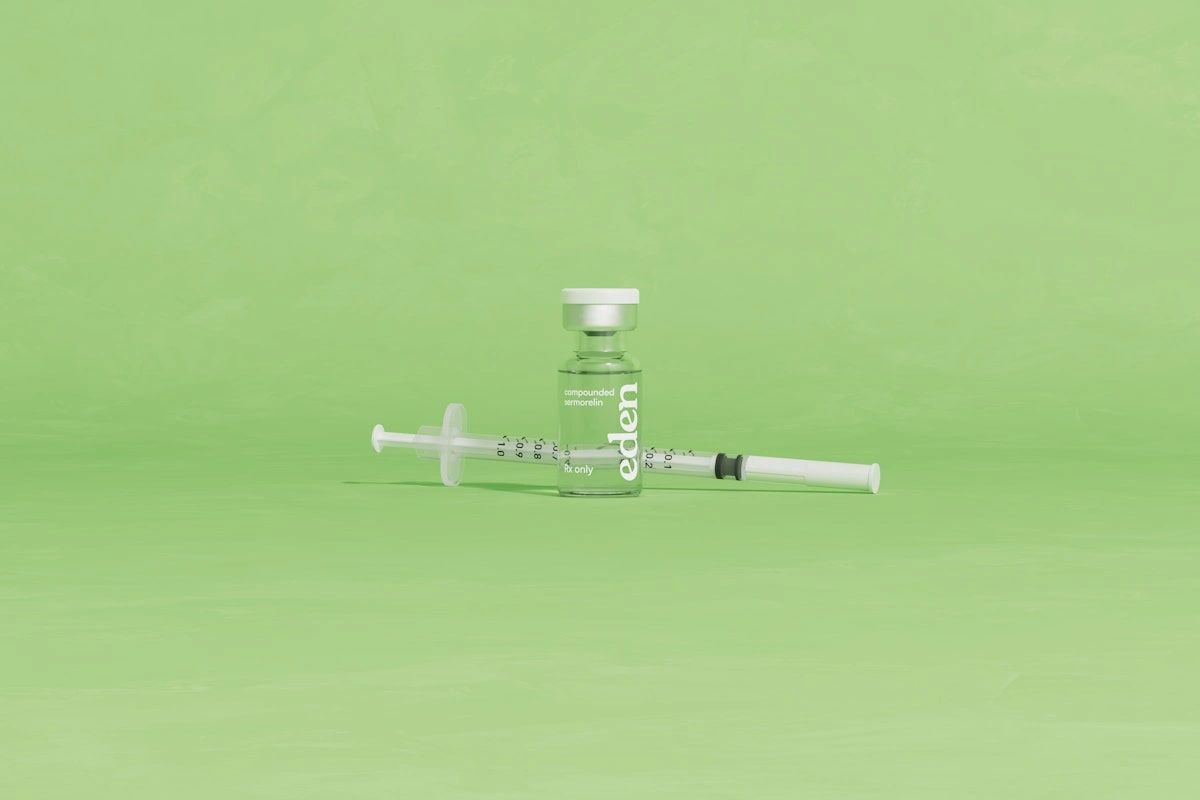How to Inject Sermorelin: Safe Subcutaneous Sites, Rotation Tips
Learn where to inject sermorelin safely, how to inject sermorelin step-by-step, site rotation, storage, and common mistakes, so that your sermorelin injection routine stays on track.
Wondering how to inject sermorelin? Understanding proper administration techniques is essential for safe use and minimizing side effects. Here are the key points to remember:
- Sermorelin is typically administered by subcutaneous injection, targeting the fatty tissue just below the skin. The stomach and thigh are common injection sites due to their accessible fatty tissue.[1][4]
- Proper injection technique involves using appropriate needle length and alternating injection sites to avoid bruising and soreness. Some individuals find it helpful to keep a written record of injection locations to ensure good rotation [4][12].
- Ask your clinician about food and timing instructions, and follow your prescription label.
- Before starting sermorelin therapy, a blood test is necessary to determine current hormone levels and the appropriate dosage.[9][10]
- As with any medication, sermorelin may cause side effects. Common reactions at the injection site include irritation, itching, and swelling. Less common side effects may include headache, dizziness, and nausea.[1][2][3]
- It's important to consult with a healthcare provider before starting sermorelin therapy, as they can provide personalized advice and monitor your progress throughout the treatment.
Important information: Sermorelin discussed here may be prescribed as a compounded medication. Compounded medications are not FDA-approved and are not reviewed by the FDA for safety, effectiveness, or manufacturing quality. Eden coordinates care; licensed providers evaluate and prescribe; partner pharmacies dispense and label.
Understanding Sermorelin and Its Uses
Sermorelin is a synthetic version of a naturally occurring substance that stimulates the release of growth hormone from the pituitary gland. This man-made peptide mimics the action of growth hormone-releasing hormone (GHRH), which plays a crucial role in regulating the body's production of human growth hormone (HGH).[1][2]
The primary use of sermorelin is to diagnose and treat growth hormone deficiency in children.[9] While children are the primary candidates for sermorelin therapy, some adults with diagnosed HGH deficiency may also benefit from this treatment.[9][10] Evidence for anti-aging or wellness benefits in otherwise healthy adults is limited; use only under clinician guidance for appropriate indications. It's important to note that definitive research supporting the anti-aging effects of sermorelin in healthy adults is still lacking.
Before starting sermorelin therapy, a blood test is necessary to determine current hormone levels and the appropriate dosage. It's crucial to consult with a healthcare provider, as they can provide personalized advice and monitor progress throughout the treatment. While sermorelin is generally well-tolerated, individuals with certain medical conditions may require additional screening or should avoid this therapy altogether.[1][2][3]
Recommended Sermorelin Injection Sites
Sermorelin is typically administered through subcutaneous injections, which target the fatty tissue just below the skin. The most common sermorelin injection sites include the abdomen, thighs, and upper arms. [1][4] These areas are preferred due to their accessible fatty tissue and ease of self-administration.[4][12]
The abdomen is a popular choice for sermorelin injections. When using this site, avoid the area within one inch of the navel. The large surface area of the abdomen makes it convenient for rotating injection locations, which is crucial to prevent tissue damage and ensure consistent absorption.[4][12]
Thighs, particularly the upper outer area, are another excellent option for sermorelin injections. This site is especially suitable for self-administration due to its accessibility and ample fatty tissue.[4]
If you have difficulty reaching other areas or prefer assistance, the upper outer arm can be used as an injection site. This location may require help from a caregiver or family member.[4]
If you came to this blog searching for “How to inject GLP-1s”, note GLP-1 medications are also administered subcutaneously in similar regions; always follow the specific instructions for your prescribed medication.[11]
Preparing for Sermorelin Injection
Before administering sermorelin, it's essential to gather all necessary supplies, including the medication vial, sterile disposable syringe and needle, alcohol swabs, and a sharps container.[4][6]
Wash your hands thoroughly with soap and water before handling any injection materials.[12]
Follow the dose and timing on your prescription label and your clinician’s instructions.
Keep a simple rotation log to track injection site rotation.[4][12] Remember to store sermorelin properly as directed on the pharmacy label; many products require refrigeration (36°F–46°F / 2°C–8°C) and protect it from light.[1][3]
Proper Injection Technique for Sermorelin
Administering sermorelin injections correctly is crucial for safe use. Use only the dose and schedule prescribed for you.
To begin, gather all necessary supplies, including the medication vial, sterile disposable syringe and needle, alcohol swabs, and a sharps container for safe disposal. Proper hand hygiene is essential, so wash your hands thoroughly with soap and water before handling any injection materials.[12] To administer the injection, choose a suitable site, such as the abdomen, thigh, or upper outer arm. Clean the area with an alcohol swab and allow it to dry.[4][12] Pinch the skin between two fingers and hold the needle at a 45-degree angle. Inject the medication slowly and carefully, avoiding pressing the plunger aggressively. [4][12]
After injection, dispose of the used syringe and needle in a sharps container.[7] To reduce needlestick injuries, do not recap needles, avoid hand-to-hand passing, and place used needles directly into an FDA-cleared sharps container.[5][6][7]
To prevent tissue damage and ensure consistent absorption, it’s important to rotate injection sites regularly.[4][12] Consider keeping a record of injection dates and locations to maintain a proper rotation schedule.
Potential Side Effects at Sermorelin Injection Sites
While sermorelin therapy is generally well-tolerated, some individuals may experience side effects, particularly at the injection sites. The most common reactions are typically mild and short-lived, often disappearing as patients become more adept at administering the injections.
Pain, redness, or swelling at the place of injection are the most frequently reported side effects.[1][2][3] These reactions are usually temporary and resolve without intervention. Some patients may also experience irritation, itching, or sensitivity at the injection site.[1][2]
To minimize these effects, it's crucial to rotate sermorelin injection sites regularly. This practice helps avoid bruising and soreness that can occur from repeated injections in the same area.[4][12]
In rare cases, more serious side effects may occur that require medical attention. If these symptoms appear, it's important to seek immediate medical care.[1][2]
Other less common side effects that may not necessarily need medical attention include dizziness, flushing, headache, sleepiness, and trouble sitting still. [1][2]
It's worth noting that as patients become more proficient in self-administering sermorelin injections, the frequency and severity of injection site reactions may decrease.[4][12]
Storing and Handling Sermorelin
Proper storage and handling of sermorelin are crucial for maintaining its effectiveness and ensuring safe use. Store according to your pharmacy label; many products require refrigeration (36°F–46°F / 2°C–8°C). [1][3] It's important to keep the medication in its original vial and store it away from children and pets.[1][3]
Follow the beyond-use date and temperature limits on your pharmacy label; if storage conditions are out of range, contact your prescriber or pharmacy.
When traveling, sermorelin can be stored in a cooler with ice packs if refrigeration is not available. It’s crucial to avoid freezing sermorelin; check your label for specifics.[1]
Proper handling also involves using sterile techniques when preparing injections. This includes washing hands thoroughly and using alcohol swabs to clean the injection site.[12]
When disposing of used sermorelin injection materials, use an FDA-cleared sharps container and follow local/municipal guidance for sharps disposal.[6][7][8]
Common Mistakes to Avoid with Sermorelin Injections
When administering sermorelin injections, it's crucial to avoid common mistakes that could affect the treatment's effectiveness or cause unwanted side effects. One of the most important aspects is proper dosing. Using too much or too little sermorelin can lead to side effects or reduced efficacy.[1][2][3]
Another mistake to avoid is improper injection technique. Sermorelin should be injected subcutaneously, targeting the fatty tissue just below the skin. Common injection sites include the abdomen, thigh, or upper arm.[4][12] Failing to rotate injection sites can lead to bruising and soreness.
Contamination is another potential issue. To prevent this, it's crucial to use sterile techniques when preparing injections. This includes washing hands thoroughly and using alcohol swabs to clean the injection site and the rubber vial stopper before puncturing it with the needle.[12] Never recap used needles and dispose of them immediately in an FDA-cleared sharps container to lower needlestick risk.[5][6][7]
Improper storage can also compromise the medication's effectiveness. Store as directed on the pharmacy label (many products require 36°F–46°F/2°C–8°C). Failing to store it correctly or leaving it unrefrigerated for extended periods can reduce its potency.[1][3]
Lastly, it's important to be aware of potential drug interactions. Sermorelin may interact with other medications, so it's crucial to inform the healthcare provider about all current medications and supplements before starting treatment.[1][2][3]
Final Thoughts
Sermorelin therapy may be considered for specific clinical indications under medical supervision. The proper administration of sermorelin, including the selection of suitable injection sites and adherence to correct injection techniques, plays a crucial role in its safe use. By understanding the recommended injection sites, proper handling and storage methods, and potential side effects, patients can work closely with their healthcare providers throughout treatment.
As with any medical treatment, it's essential to approach sermorelin therapy with caution and under professional guidance. Regular consultations with healthcare providers, careful monitoring of progress, and adherence to prescribed dosages are key to safe use. Eden coordinates care; licensed providers evaluate and prescribe; partner pharmacies dispense and label.
Disclaimer: The FDA does not approve compounded medications for safety, quality, or manufacturing. Prescriptions and a medical evaluation are required for certain products. The information provided on this blog is for general informational purposes only. It is not intended as a substitute for professional advice from a qualified healthcare professional and should not be relied upon as personal health advice. The information contained in this blog is not meant to diagnose, treat, cure, or prevent any disease. Readers are advised to consult with a qualified healthcare professional for any medical concerns, including side effects. Use of this blog's information is at your own risk. The blog owner is not responsible for any adverse effects or consequences resulting from the use of any suggestions or information provided in this blog.
Eden is not a medical provider. Eden connects individuals with independent licensed healthcare providers who independently evaluate each patient to determine whether a prescription treatment program is appropriate. All prescriptions are written at the sole discretion of the licensed provider. Medications are filled by state-licensed pharmacies. Please consult a licensed healthcare provider before making any medical decisions.
Frequently asked questions
Sermorelin should be injected subcutaneously, which is under the skin. Be sure the rubber vial stopper is sanitized with an antiseptic before inserting the needle. Aim to inject into the fatty tissue beneath the skin, commonly in the stomach or thigh areas. Follow the specific preparation and injection instructions provided by your clinician and dispensing pharmacy.[4][12]
Blog Components



References
- Mayo Clinic — Sermorelin (Injection Route): Description / Proper Use / Side Effects. https://www.mayoclinic.org/drugs-supplements/sermorelin-injection-route/description/drg-20065923
- RxList — Sermorelin Acetate (Sermorelin): Uses, Dosage, Side Effects, Interactions, Warnings. https://www.rxlist.com/sermorelin-acetate-drug.htm
- Drugs.com — Sermorelin Acetate: Patient Information & Monograph
https://www.drugs.com/cdi/sermorelin-acetate.html - StatPearls (NCBI Bookshelf) — Medication Routes of Administration (subcutaneous overview). https://www.ncbi.nlm.nih.gov/books/NBK568677/
- StatPearls (NCBI Bookshelf) — Needlestick (general injection safety context)
https://www.ncbi.nlm.nih.gov/books/NBK493147/ - FDA — Safely Using Sharps (Needles and Syringes) at Home, at Work, and on Travel
https://www.fda.gov/medical-devices/consumer-products/safely-using-sharps-needles-and-syringes-home-work-and-travel - FDA — Best Way to Get Rid of Used Needles and Other Sharps. https://www.fda.gov/medical-devices/safely-using-sharps-needles-and-syringes-home-work-and-travel/best-way-get-rid-used-needles-and-other-sharps
- CDC/NIOSH — Safe and Proper Sharps Disposal (guidance). https://www.cdc.gov/niosh/healthcare/hcp/pandemic/sharps-disposal-mass-vaccination.html
- Endocrine Society — Evaluation and Treatment of Adult Growth Hormone Deficiency (Clinical Practice Guideline). https://academic.oup.com/jcem/article/96/6/1587/2833853
- AACE — 2019 Clinical Practice Guideline: Management of Growth Hormone Deficiency in Adults. https://pro.aace.com/clinical-guidance/2019-clinical-practice-guideline-management-growth-hormone-deficiency-adults
- NIH DailyMed — Semaglutide Injection (FDA Prescribing Information; for neutral note on SC sites). https://dailymed.nlm.nih.gov/dailymed/search.cfm?labeltype=all&query=semaglutide%20injection
- WHO — Best Practices for Injections and Related Procedures Toolkit (general technique/safety principles). https://apps.who.int/iris/handle/10665/44298
The wellness insight you need, without the noise.





















